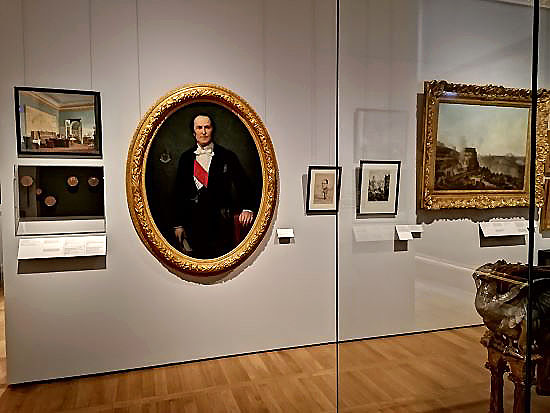LA COMMUNE NOW OCCUPIES FOUR METERS, SANDWICHED BETWEEN SPACES ABOUT ELITES
The first space is devoted to the Baron Haussmann...
La Commune is inserted in the short corridor that links those topics. It starts with an account whose errors don't matter because few people will read the small letters.
The 72 days of the Commune of Paris
(March 18 - May 28 1871)
The defeat leaves France divided. The decapitalization of Paris in March is rejected by the Parisian population. [No mention of social measures.] The national guards create a republican federation (hence the name "fédérés") and regroup on the heights of Montmartre and Belleville. [And throughout the underclass east, north and south]. Adolf Thiers, head of the executive power, orders that 277 cannons [no, 177: an error that reveals the writer's ignorance, as here and here] of Montmartre be taken back, but his troops retreat to Versailles. The political leader and writer Jules Vallès writes, "Paris is reconquered." [An individual replaces the humble population.] On March 26 a general council is elected, in homage to the insurrectional commune of 1792-1794. It is the first experience of communal self-government in [untrue for Paris and for a number of European cities] revolutionary history. The Commune is proclaimed on March 28. A number of measures are adopted (separation of Church and State, recognition of concubinage, election of officials and judges, citizens' control of officials, education of girls... ) [Skips measures that contest the social hierarchy]. But on May 21 mai, Thiers's army invades south-western Paris. The Communards set fire to a number of public buildings on May 23 and 24 [Nothing on army destructions]. 7000 - 10,000 people [a number that is much too low] die during Bloody Week (May 21-28 1871), which marks the end of the Commune.
- Then comes a work about communicating by balloon during the siege of Paris, a service whose cost reserved it to the wealthy. Huge, it eats into part of La Commune's minuscule space.
In what's left:
- On the right, portraits of a revolutionary leader who was absent because imprisoned at Versailles, of a woman who was a child at the time of La Commune, of a journalist who went over to the far right and of Louise Michel, who at the time was relatively obscure:
From left to right
- Auguste Blanqui. As a prisoner of Versailles he played no role in La Commune.
- Jules Vallès's compagnon in the 1880's, who was 13 at the time of La Commune.
- Bust of the marquis Henri de Rochefort, a journalist who later changed sides.
- Louise Michel, obligatory.
- One must peer closely to see two small images of carnage: That behind the arrow is practically invisible and the photo's blur shows how hard it is to make out the larger picture of the firing squad.
The museum renews the exhibit by replacing these with other images of army violence, which are as small and as difficult to decipher.
Around the corner, the usual emphasis on destruction by the Communards...
The small objects in the niche above the picture of ruined City Hall concern its past, not La Commune, unless to emphasize its destruction.
But nothing about that of the army.
# # #
I happened to be present when a high school class arrived. The teacher mentioned Baron Haussmann and the Second Empire, then walked through the passage without mentioning La Commune.
# # #
I have several times asked young guards
how to find that exhibit.
They do not know
and have never heard of La Commune itself.
* * *
Next,













No comments:
Post a Comment